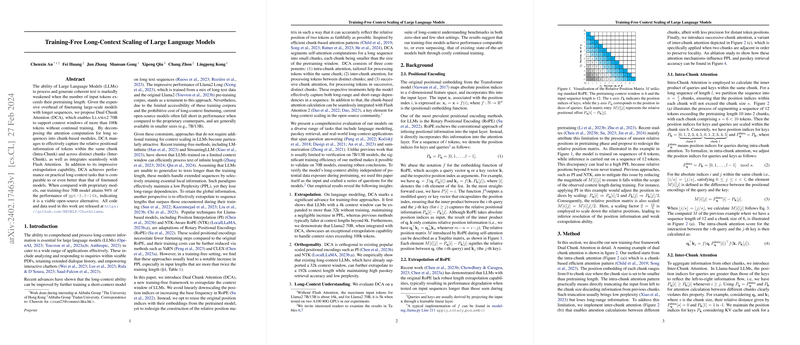Training-Free Long-Context Scaling of LLMs: Dual Chunk Attention
The paper, authored by Chenxin An and colleagues, introduces Dual Chunk Attention (DCA), an innovative approach designed to scale the context window of LLMs without necessitating additional training. This work focuses on expanding the effective context length of models such as Llama2, allowing them to consistently process and generate text for sequences exceeding their original training limits. The proposed method is particularly notable for enabling Llama2 70B to handle context windows of over 100k tokens, directly addressing the limitations imposed by the pretraining context length.
Introduction
At the core of this research is the challenge of maintaining coherence and processing efficiency in LLMs when dealing with long-context inputs. Existing LLMs are typically pretrained with a fixed context window, and fine-tuning them for longer sequences is often resource-intensive. Previous methodologies to extend the context length, such as Position Interpolation (PI) and NTK-Aware Rotary Positional Encodings (RoPE), require additional training steps or introduce significant PPL inflation with extended input lengths. This paper presents a sophisticated yet efficient alternative, focusing on a training-free paradigm.
Methodology: Dual Chunk Attention (DCA)
The DCA framework introduces a novel approach by segmenting the attention computation of long sequences into chunk-based modules. This allows for capturing both intra-chunk and inter-chunk positional information effectively, integrating with Flash Attention to enhance performance and efficiency. DCA consists of three critical components:
- Intra-Chunk Attention: This processes tokens within the same chunk, maintaining a fixed chunk size smaller than the pretraining window.
- Inter-Chunk Attention: This mechanism allows attention computations across different chunks, thereby preserving long-range dependencies.
- Successive Chunk Attention: This is designed to maintain locality by adjusting the position indices of tokens in neighboring chunks, ensuring accurate position representation for closely spaced tokens.
Through these components, DCA manages to retain global information and minimize perplexity across sequences, even when significantly extending the context length beyond the pretraining limits.
Numerical Validation
The experimental results presented in this paper underscore the efficacy of DCA. For instance, the Llama2 70B model, when equipped with DCA, achieves a perplexity (PPL) of 5.59 with a context length of 100k tokens. This is a negligible increase from its baseline PPL, showcasing DCA's ability to handle long-range dependencies efficiently. This performance stands in stark contrast to training-free methods such as PI and NTK, which show considerable PPL inflation beyond context lengths of 8k tokens.
Practical and Theoretical Implications
Practical Implications: DCA provides a cost-effective solution for various applications requiring the processing of extensive text sequences. This includes scenarios like analyzing extensive PDF documents, retaining long dialogue histories in conversational agents, or enabling high-resolution data summarization. By circumventing the need for repetitive and resource-intensive fine-tuning, DCA makes a strong case for practical deployment in real-world LLM applications.
Theoretical Implications: The introduction of chunk-based attention mechanisms with explicit intra-chunk and inter-chunk attention offers new insights into positional encoding and relative position matrix designs. This can stimulate further research into more refined attention mechanisms that can bridge the gap between local and global context comprehension in LLMs.
Future Directions
Given the promising results, future research might explore several avenues:
- Optimization of Chunk Sizes: Analyzing the impact of varying chunk sizes on different model architectures and datasets could yield even more optimized configurations.
- Hybrid Approaches: Combining DCA with other novel training-free approaches might further enhance the performance and scalability of LLMs.
- Application Specific Tuning: Tailoring the DCA methodology for specific application domains such as biomedical text mining or legal document analysis could significantly advance domain-specific LLM capabilities.
Conclusion
The Dual Chunk Attention method presented by the authors marks a significant advance in the field of LLMs by enabling training-free long-context scaling. With robust numerical results and practical evaluations, DCA stands out as a highly efficient tool for extending the context windows of LLMs. This work not only provides an immediate solution to existing limitations but also paves the way for future advancements in scalable LLMing. The open-sourcing of their code and data further enhances the potential for community engagement and iterative improvement in this critical area of machine learning research.
